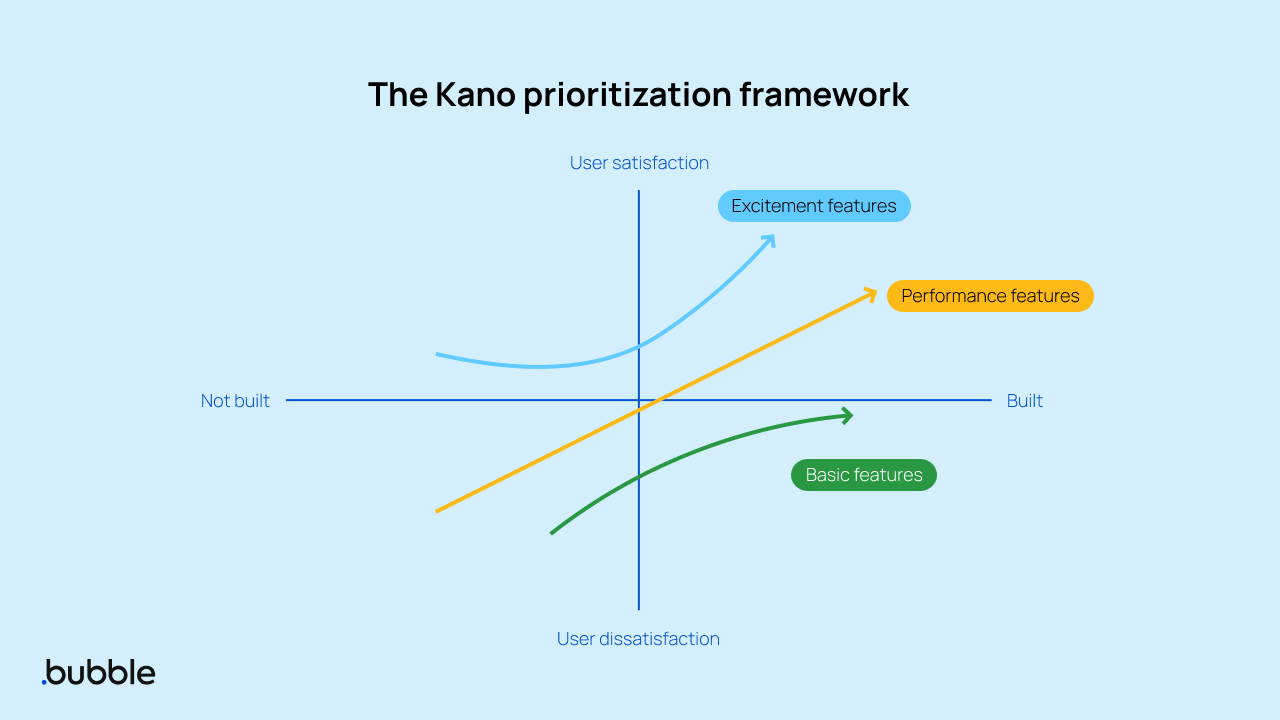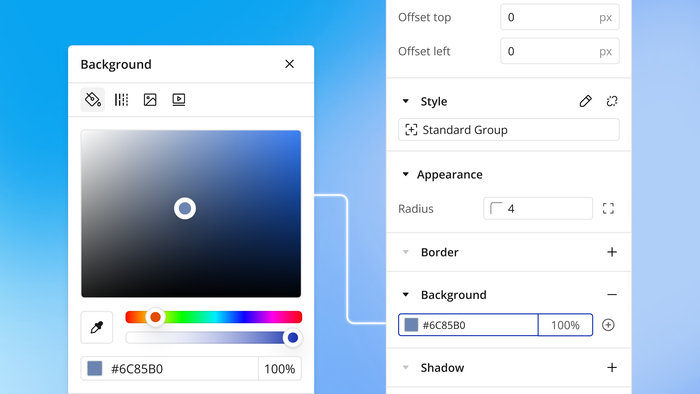Our internal product leads agree: Prioritization is one of the toughest parts of product management.
That’s why having a framework can be so helpful.
There’s a lot of elements to consider when planning your development roadmap. Having a logical — even quantitative — framework makes it much easier to make quicker, more insightful decisions.
In this article, we’ll break down the following product management frameworks so you can find the one that makes the most sense for your team:
- RICE
- Kano
- User story mapping
- MoSCoW
- Jobs to Be Done
- Cost of Delay
- Impact x Effort
- Opportunity Scoring
What are product management prioritization frameworks?
Product management frameworks give your team a structure to decide which initiatives or features should be prioritized on your product roadmap or in the next development cycle.
Instead of using intuition or hashing it out over Zoom, you can follow an agreed-upon framework to clearly analyze proposed initiatives and decide which are going to be the most effective and deliver the highest impact with the time, resources, and budget you have available.
“Prioritization is always tricky and can be an art as much as a science.
It’s important to make sure you consider all the angles, and frameworks can be helpful for this (for example, RICE). But in general, make sure you’ve analyzed relevant quantitative data, spoken to customers, and considered your long-term vision for the product and your business.” — Steve Harrington, Lead Product Manager at Bubble
Why is a product management framework helpful?
Prioritization is one of the trickiest aspects of roadmapping and product management. A good framework gives you a place to get started.
Even better: A great framework gives you and your team a way to get on the same page about how to prioritize features. It also provides logical insight into which features and initiatives best align with your bigger vision.
Beyond the basics, here are four key reasons a prioritization framework can help your team.
Supporting product strategy
Having a prioritization framework can do wonders in helping support your product strategy. You’ve already cast your product vision, but sticking to it and executing it well is often a lot harder.
A good prioritization framework can help you build a product roadmap that aligns with your business objectives, and makes the complex process for product planning less opaque.
Keeping things customer-focused
Another benefit: product management frameworks can help you balance what needs to be prioritized internally alongside meaningful customer-facing changes as well.
It’s important to show progress to your user so they know things are getting better and remain confident in your product for the future. You want to avoid going multiple quarters without any meaningful customer-facing changes. Consider using your roadmap to help you plan to mix in some smaller customer-facing wins even if the majority of your time is being spent on building out a longer term project.” — Steve Harrington, Lead Product Manager at Bubble
Customer-focused prioritization frameworks (particularly the kano model and user story mapping) focus on understanding the customer journey and customer needs to identify the right product ideas to delight customers.
Streamlining product development
When you’re moving from big-picture strategy to tactical development, there’s a lot of moving pieces to consider. A prioritization framework makes it easier to identify opportunities, which helps streamline the development process.
Instead of wasting time developing a bunch of features that end up being not that impactful, you can use a tried-and-true framework from the start to figure out which features matter most, gain insights into customer journeys, and define the highest-value opportunities — without so much trial and error.
Improving team collaboration
Last, but definitely not least: with the right framework, you can align your entire team on the same page and move forward faster, together.
A framework makes it much easier for your product team to communicate and collaborate with your development team, sales team, and other stakeholders.
Our top 8 prioritization frameworks
There’s so many helpful product management frameworks for prioritizing your product roadmap and development. Here are our favorites, and when you should use them.
1. RICE framework
The RICE framework is a classic prioritization framework for product management. It uses a simple scoring model to evaluate each potential feature or initiative against four categories: Reach, Impact, Confidence, and Effort.

Reach measures how many users will notice or be affected by a new feature across a given period. Will this impact our entire audience or a select group?
Impact measures how strongly affected users will be impacted by the feature (i.e. is this a high-impact change or a minor update?).
Confidence measures how sure you are about your estimates of reach and impact. Do we have a lot of concrete data to assume this, or is it an educated guess?
Effort measures how much time and resources will be required to ship this feature (i.e. the number of employee hours it’ll take to get something done).
With RICE, you can clearly gauge which features or initiatives have the highest reach and impact, and prioritize them accordingly based on estimated effort and confidence. Start with your high-impact, sure bets and align other items on your roadmap based on your team’s availability.
• You're a larger team juggling a lot of initiatives
• You want a quantitative way to prioritize features
• You have enough experience and data to effectively estimate “reach” and “effort”
2. Kano framework
The Kano model puts user satisfaction at the forefront of prioritization by mapping all features onto a graph with just two factors:
- Customer satisfaction
- Implementation value

The goal is to measure the proportion of customer delight or satisfaction that can be gained from implementing different features. With Kano, you can essentially sort features into four main categories:
- “Excitement” features: Users don't expect these or “need” them to solve their problems, but they’ll delight your audience if you do have them.
- “Performance” features: Features where the level of customer satisfaction is proportional to the level of investment — the more you invest in them, the more delighted customers will be.
- “Basic” features: Features that users expect and need from your product. More investment here is needed simply to meet customer expectations.
- “Indifferent” features: Features that customers simply don’t care about (or don’t need). Investing in these won’t cause any change in customer satisfaction.
• You want to emphasize user satisfaction in your prioritization strategy
• You're in the early stages of product development
• You're still trying to identify the “must-have” features and biggest wins
3. User story mapping
User story mapping is a common technique that fits well within agile frameworks. The goal of user story mapping is to focus on the user experience. From there, you’ll be able to prioritize which features are most crucial for (and can most enhance) that experience.
User story mapping has three main steps:
- First, you’ll identify the core journeys (or stories) users will take with your product. What are their key goals and what core tasks are they trying to accomplish with your product?
- Next, break down each step of the user journey as boxes or sticky notes across the top of your map.
- Underneath each one, list the tasks, steps, or features users need to have to accomplish that step in the process. Each feature or task should be sorted with the highest-priority features at the top.
This results in a map that shows the entire user journey with your product. Relevant features are ranked by stage of the journey and priority, helping your team get a clear picture of user experience, identify gaps, and prioritize high-value features for your audience.
For example, a messaging app might make a user story mapping that looks something like this:

• You want to center user experience when prioritizing features
• You're already working within an agile framework
4. MoSCoW framework
The MoSCoW framework is super versatile: It can be used by teams of all sizes, at any stage of product development.

It sorts all your potential features into four stages:
- Must-haves: non-negotiables for your product vision at this stage
- Should-haves: important to the product overall, but not vital or urgent at the current stage
- Could-haves: desirable features that aren’t yet important
- Won’t-haves: features that would be nice to have, but have no measurable impact or are outside the current budget or scope
The MoSCoW framework is great at helping prioritize features for the current iteration of your product, whether that’s a minimum viable product (MVP) or V1, or whether you’re a lot further down the road. Either way, it gives you a way to chart out what’s needed right now, and what can be tabled for later.
• You need an intuitive method of sorting features
• You don’t need or have a lot of quantitative data for prioritizing
5. Jobs to Be Done framework
The Jobs to Be Done (JTBD) framework works a little differently than many other product management frameworks on this list.
Instead of starting with product ideas or features and then prioritizing them based on different categories, it backs up even further — to the motivation or “job” to be done that causes a user to try your product in the first place. By understanding what the user wants to accomplish, you can more effectively create innovative solutions and prioritize features that'll most effectively help users accomplish those goals.
With the JTBD framework, you need to thoroughly interview customers to understand their motivations and goals related to your product, and then sort jobs to be done into three loose categories:
- Functional jobs: The primary tasks they’re trying to accomplish
- Emotional jobs: How they want to feel or avoid feeling in relation to this job
- Social jobs: How they want to be perceived by others

By better understanding these jobs and motivations, you can be more innovative in how your product helps users accomplish those jobs. Focus your product development on crucial unmet jobs that are really valuable to your target audience.
• You're exploring new product or market opportunities You want to uncover unmet needs in your target market
• You need to better understand customer motivations and goals to differentiate your product features
6. Cost of Delay framework
The Cost of Delay framework helps product managers estimate the financial impact of prioritizing — or de-prioritizing — any given feature, allowing you to see and prioritize features based on potential value.
First, you’ll calculate how much time and effort each potential feature will take to build. Then, ask your team these three questions for each potential feature:
- How much will this feature be worth (or what revenue would it generate) once we build it?
- How much would it be worth if it gets built earlier than planned?
- How much would it cost if it gets delayed?
Using your estimates above, you can figure out via these questions which features have the highest potential financial value for the level of effort required, and prioritize accordingly.

• You want to better understand the potential financial impact of your backlog or potential features
• You need a quantitative way to prioritize features and projects
• You want to focus on speed and value instead of cost and efficiency
7. Impact x Effort Matrix
This framework (sometimes called a “Value vs. Effort” matrix) plots features against two values:
- Impact: how much this will benefit the user
- Effort: how much time or resources this will take
As a result, all features get sorted into four categories:
- Quick wins: low-effort, high-impact projects that'll have an outsized impact on user experience given their effort level
- Important projects: high-effort, high-impact projects that'll require a longer build time, but one that’s worth it given the impact to the user
- Fill-ins: low-effort, low-impact projects that are quick and easy, but don’t change much from a user perspective
- Time wasters: high-effort, low-impact projects that should generally be avoided, unless the impact they’ll have internally can justify the effort
In general, you can use this matrix to clearly prioritize quick wins and important projects, while tabling fill-ins and time-wasters unless budget and internal impact increases their value.

• You don’t have enough data to effectively use a RICE framework
• You're a small team moving fast
• You're in the early stages of product development
8. Opportunity Scoring
Opportunity Scoring works on a similar framework as the Kano model, but it surveys users about already-existing features rather than potential ones.
With Opportunity Scoring, you rank opportunities (or outcomes) on a graph that plots importance against customer satisfaction. For example, you may brainstorm 10 features or outcomes that could be accomplished with your product, and then ask customers to both:
- Rank the given outcomes in order of importance, and
- Identify how satisfied they are with the current solution / feature for that outcome.
From there, you can see the features that are:
- Overserved: features that aren’t as important to users, but they’re very satisfied with your solution
- Appropriately served: features that are important and users are satisfied with
- Underserved: features that are very important to users, but they aren’t satisfied with your solution for
In the next sprint or upcoming releases, you can then prioritize the underserved features or outcomes to improve customer satisfaction and increase product-market fit.

• You're looking to prioritize features to improve an existing product
• You want to identify areas for innovation or gaps in your solution
Pro tip: The Opportunity Scoring model fits in nicely with the Jobs to Be Done framework — some teams like to use them both in tandem!
How to choose a product management framework
Remember, the goal of a good prioritization framework isn’t to spit out exactly what you should do next, or replace your team’s experience or intuition. The goal is simply to get everyone on the same page and make it easier to balance and consider the many different prioritization factors.
So, which framework is right for your team?
Look for a product management framework that:
- Allows your whole team — big or small — to get on the same page. Some frameworks work better for larger or smaller teams, as mentioned above.
- Gives you tangible ways to sort and prioritize upcoming features and work.
- Fits within your current product stage and wider business priorities. For example, teams working on launching a product’s first iteration will likely find it easier to use the JTBD framework than Opportunity Scoring.
- Helps you quickly table some features as “for later.” If you’ve ended your framework brainstorming session and found that all the features you have in mind are urgent, your prioritization framework hasn’t helped you.
Alos, keep in mind that many product teams use more than one framework or pull in a few frameworks at different points in the product development process. There’s nothing wrong with combining them or using more than one to narrow down your goals even more.
Just make sure that you don’t spend so much time planning and roadmapping that you don’t get down to development and launching. Sometimes the best way to know which features are most important to your target audience is to build some, launch your product, and iterate based on customer feedback.
Start executing your product roadmap with Bubble
When you’ve got your roadmap in place with prioritized features and development work, Bubble can help you move faster, launch sooner, and scale quickly.
No-code tools like Bubble can help you shave months (or years!) off your development work. Not to mention, they make development much more cost-effective, requiring way fewer resources and less time.
With Bubble, you can develop and launch your product in just weeks, giving you a solid V1 that you can then iterate on directly and keep growing and scaling as you gather customer feedback.
Build for as long as you want on the Free plan. Only upgrade when you're ready to launch.
Join Bubble






